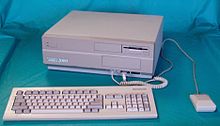Amiga 2000
The Amiga 2000 is a personal computer from the Amiga series. It represents the high-end counterpart to the Amiga 500 , which was also released in 1987 .
The Amiga 2000 was designed as a desktop computer , in contrast to the Amiga 500. In the larger housing there was space for extensions via the Zorro bus . This enabled (comparable to the PCI standard specified five years later ) Autoconfig (comparable to Plug and Play with Windows ), while IBM-compatible PCs were mostly equipped with ISA slots at that time .
The Amiga 2000 was supposed to occupy the professional segment, in contrast to the parallel model Amiga 500, which was mainly limited to the area of image processing and TV stations.
Various special chips
The Amiga 2000 differed in the different mainboard models (A and B) and the special chips on them.
The first model, the Amiga 2000A, was designed in Germany in the Braunschweig development department. It was equipped with an OCS chipset and the Agnus chip of the Amiga 1000, which enables a maximum of 512 kB of chip RAM , but which could not be expanded.
In the Amiga 2000B (developed in the USA), which appeared in 1988, the Fat Agnus chip was used, which could manage 1 MB of chip RAM. However, later versions of the B-model contained the ECS chipset with Super Big Agnus , which was then also used in the Amiga 3000.
The ECS chipset was then only installed in the 1990 revision 6.x (only called A2000C by some users), with this 2 MB chip RAM was possible.
Furthermore, the Amiga 2000, like the Amiga 500 , has the Kickstart in the ROM compared to the Amiga 1000 , that is, it does not have to be loaded from a diskette when you start the computer.
Successor models within the Amiga series are the Amiga 3000 and 4000 .
Technical Equipment
- CPU : Motorola 68000 7.14 MHz (NTSC) or 7.09 MHz (PAL), alternatively you could replace the 68000 with a 68010 .
- Chipset : OCS (original chipset), from revision 6.x ECS
- RAM : 1 MB ( megabyte ), whereby the Amiga 2000A had 512 KByte on the motherboard and 512 KByte on a memory expansion ('Ranger Card') in the CPU slot. The Ranger Card could be upgraded to 1 MByte with individual memory chips, so that a total of 1.5 MB RAM was available. All subsequent revisions had 1MB on the motherboard; Expandable up to 9 MB, with PC bridge card up to 7 MB
- ROM : 256 kB for Kickstart 1.2 / 1.3 later Kickstart 2.0 with 512 kB
- internally 5 Zorro II slots (16 bit, autoconfig), 2 in series with the 16 bit ISA slots for the bridge cards (PC card, see A1060 Sidecar )
- internal 2 16-bit ISA slots (2 in series with Zorro II slots, see above)
- internal 2 8-bit ISA slots
- an internal extension slot (CPU slot) - for CPU cards with 68020 , 68030 or 68040 processors (fastest card: 68060 with 50 MHz (Blizzard 2060))
- internally a video slot - for genlocks, flicker fixer cards etc. (with the 2000A there is only one genlock port)
- a parallel port (SSP)
- an RS232 port
- One audio output each left / right audio channel ( cinch , for direct connection e.g. to a stereo system)
- a video monochrome out
- 2 internal connections for floppy disk drives (a 3.5 inch 880 kB drive included)
- an external floppy port (the Amiga could manage up to 4 floppy drives).
- Operating system: AmigaOS 1.2 / 1.3 ( Kickstart 1.2 / 1.3, Workbench 1.2 / 1.3) or AmigaOS 2.0 (Kickstart 2.04, Workbench 2.04)
Model variants
Amiga 1500
The Amiga 1500 is a variant of the Amiga 2000 with an additional internal floppy disk drive (two in total).
It was mainly sold by Commodore England.
Amiga 2500
The Amiga 2500, which came on the market in 1989, corresponds to the Amiga 2000, hardware revision 6.2 and higher. It was equipped with a 68020 (A2620) or 68030 CPU card (A2630) and a SCSI controller (A2091) with a SCSI hard disk.
Amiga 2500 / UX
The Unix derivative AMIX was included in the scope of delivery of the Amiga 2500 / UX .
Web links
Individual evidence
- ↑ Commodore Amiga A500 / A2000 Technical Reference Manual. (pdf; 14.5 MB) 1987, archived from the original on June 13, 2012 ; accessed on April 13, 2018 (English).
